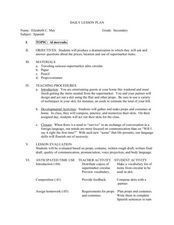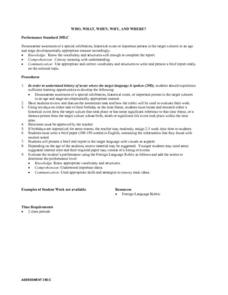Curated OER
French and Family
Where is France? Interest young learners in exploring France, French language, and French culture. They identify similarities and differences between French and American families, speak the French words for family members, analyze maps,...
Curated OER
Al Mercado
Students investigate the concept of a market. They produce a dramatization to simulate the daily activities found inside. Students ask questions about the price, location, and use of items. The acting strengthens communication skills and...
National Endowment for the Humanities
La Familia
Young scholars identify at least one country where the Spanish language is spoken, describe similarities and differences between Spanish, Mexican, and Puerto Rican families, and practice speaking the Spanish words for several family...
Curated OER
Sippin' on Smoothies
Why is calcium good for the body? Where is it stored? Young chefs discover the importance of calcium and review a list of foods that are rich in the material. They then make delicious smoothies high in calcium! Teaching kids how to...
Curated OER
Who, What, When, Why, And Where?
Students identify and more completely research a historical event that coincides with their own birthday. They then write a report about the event or a person whose birth, death, or life took place within that same timespan and/or...
Curated OER
Sign Language
Pupils create short video tutorials on various American Sign Language signs. This lesson plan is a six-day project that begins with internet research and ends with student self-evaluations of project results.
Curated OER
Hispanics in Indianapolis
Eighth graders explore the history of the Indianapolis Hispanic Community and create an illustrated timeline of Hispanics in Indianapolis beginning from 1870 and ending in 1999, while exploring local social issues of the past and present.
Curated OER
Where In The World?
Students identify the goods and services from the United States and Mexico. Using postage stamps, they describe the various images they see and place them into categories. They use those categories to determine what is important in...







